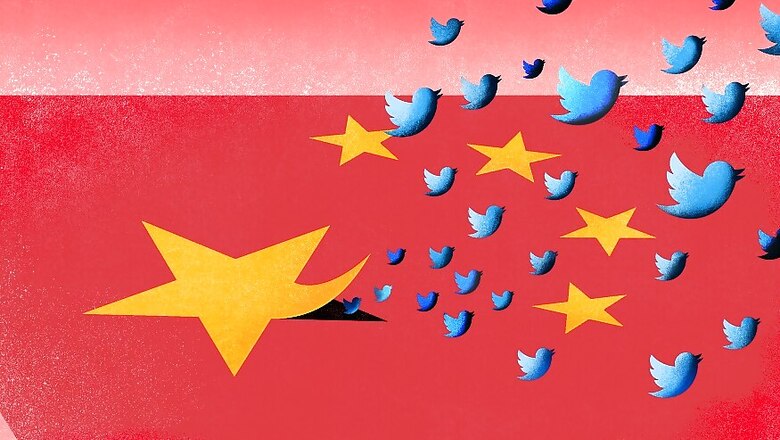
views
As the Trump administration lashes out at China over a range of grievances, Beijing’s top diplomats and representatives are using the president’s favorite online megaphone — Twitter — to slap back with a pugnaciousness that is best described as Trumpian.
Behind China’s combative new messengers, a murky hallelujah chorus of sympathetic accounts has emerged to repost them and cheer them on. Many are new to the platform. Some do little else but amplify the Beijing line.
No doubt some of these accounts are run by patriotic, tech-savvy Chinese people who get around their government’s ban on Twitter and other Western platforms. But an analysis by The New York Times found that many of the accounts behaved with a single-mindedness that could suggest a coordinated campaign of the type that nation states have carried out on Twitter in the past.
Of the roughly 4,600 accounts that reposted China’s leading envoys and state-run news outlets during a recent week, many acted suspiciously, The Times found. One in six tweeted with extremely high frequency despite having few followers, as if they were being used as loudspeakers, not as sharing platforms.
Nearly 1 in 7 tweeted almost nothing of their own, instead filling their feeds with reposts of the official Chinese accounts and others.
In all, one-third of the accounts had been created in the past three months, as the war of words with the Trump administration heated up. One in seven had zero followers.
The United States and China are battling to dominate the global narrative. China was criticized for its early mishandling of the coronavirus outbreak, but it has regained confidence as other countries have made their own stumbles. With the United States in turmoil, upended first by the epidemic and now by protests, Beijing sees a chance to define itself as a global leader, one unafraid to press its interests in Hong Kong and the region.
It is far from clear that the Chinese government is behind the swarms of accounts helping to spread its gospel on Twitter. Online information campaigns are becoming increasingly sophisticated as malicious actors get better at disguising their digital activity, security experts say. They now rarely make telltale mistakes such as using social media accounts that were all created on the same day, follow one another and post the same material.
Campaigns are often uncovered one small piece at a time. Twitter has declared operations to be state-backed after identifying as few as six accounts.
Much is unknown about China’s covert influence activities in particular. Twitter last year suspended more than 200,000 accounts that it called a Chinese state-backed operation aimed at discrediting Hong Kong’s protesters, although it said little about how it came to that conclusion.
Still, The Times’ findings add to other recent evidence suggesting that Twitter is being manipulated to amplify pro-Beijing messages. Next Dim, a data firm in Israel, discovered two mundane-looking tweets praising China’s coronavirus response that were liked and reposted hundreds of thousands of times in March, possibly with the help of strategically placed influencer accounts.
The US State Department found inauthentic-seeming accounts that in April cited a Cambridge University study to raise doubts that the coronavirus originated in China. The most active of these accounts referred to the study in scores of tweets, even though the study’s lead author dismissed that interpretation of its findings.
Neither Next Dim’s findings nor the State Department’s have been previously reported.
“Improving the health of the public conversation is a priority for our company,” Twitter said in a statement. “Platform manipulation, including spam and other attempts to undermine the public conversation, is a violation of the Twitter Rules.”
The State Department has denounced China’s efforts to burnish its image and drown out criticism during the pandemic, comparing them to Russia’s disinformation campaigns. Both countries are using a range of tools to “shape and tilt any given information environment in their favor,” said Lea Gabrielle, coordinator of the department’s Global Engagement Center.
“I think the Chinese Communist Party is still trying to define its relationship with Twitter,” said Kristine Lee, a fellow at the Center for a New American Security. “But the COVID-19 pandemic has served as an important period of experimentation.”
The US-China tongue-lashing adds to the questions vexing Twitter about how it treats inflammatory or misleading remarks from world leaders. Trump has accused the company of censoring him and other Republicans while ignoring questionable posts by Democrats and the Chinese government.
Beijing’s Twitter brigade includes Hua Chunying, the head of the foreign ministry’s information department. Since joining the platform in October, Hua has attracted more than half a million followers with her feisty put-downs of the United States.
In a Communist Party journal last year, Hua wrote that China had to find a voice in international affairs that was commensurate with its economic strength. “We have walked closer to the center of the world stage than ever before, but we still do not grasp the microphone completely in our hands,” she wrote.
One reason, she wrote: a lack of “fighting spirit.”
Another foreign ministry spokesman, Zhao Lijian, became notorious after tweeting that the U.S. military might have brought the coronavirus to China. Twitter later added a fact-checking label to Zhao’s post.
The Times analyzed all of the tweets that Hua, Zhao and 12 other Twitter users linked to the Chinese government posted between May 18 and May 25.
The other users included the foreign ministry’s main account, as well as the accounts of China’s ambassadors to the United States and Britain. They also included nine accounts run by state news outlets.
That week, Beijing moved to tighten its control over Hong Kong. Trump threatened to cut off funding to the World Health Organization. U.S. officials congratulated Taiwan’s president on the start of her second term. China, which claims Taiwan as its territory, was furious.
Hua mused about whether the coronavirus actually originated in the United States: “Scientists at the US NIH began developing a #COVID19 vaccine on January 11. There were reports of cases as early as November last year. Any explanation or investigation?” Her post, which refers to the National Institutes of Health, was liked 4,600 times.
The Times’ analysis found that hundreds of the 4,600 accounts that reposted the Chinese government mouthpieces that week behaved suspiciously. Many were incessant tweeters despite having limited followings. After excluding accounts that had zero followers and had tweeted five times or fewer, over one-sixth of the accounts had posted 100 or more times for every follower.
A few accounts repeatedly retweeted at set lengths of time after the original post — 9 hours and 49 minutes after, 19 hours and 34 minutes after — suggesting that software had been used to schedule their tweets. Twitter has since suspended some of the accounts for violating its policies.
When contacted by The Times, several pro-China Twitter users denied being part of a government campaign but acknowledged that they joined the platform specifically to follow the foreign ministry representatives. The ministry did not respond to a request for comment.
Others said they were either curious about Trump’s tweets about China or felt demonized by them.
“He has done so many shameless things for re-election,” one user, @beautifullady76, said in a Twitter message. “Countless Chinese people are angry and everyone has the right to the truth. We just want to say a fair word for China!”
Public records show that Beijing is trying to expand its influence on the Western internet. China’s internet regulator has sought out contractors to help it “make use of overseas social media platforms to develop online propaganda on major themes,” procurement documents show.
Much of this kind of activity may not appear in official documents, however. The regulator did not respond to a request for comment.
“There’s no reason to think that the parts of the Chinese government that are formally in charge of conducting information operations are not able to conduct operations that are as sophisticated as others’,” said Camille François of the network analysis company Graphika. “They just haven’t been publicly exposed and dissected yet.”
Researchers remain on the lookout. ProPublica tracked 10,000 fishy accounts that posted about the coronavirus and the Hong Kong protests. Alkemy, an Italian digital marketing firm, found that inauthentic-looking users were behind many posts celebrating Chinese medical aid to Italy.
In March, two tweets lauding China’s handling of the outbreak were liked and reposted hundreds of thousands of times. The posts were not shocking, funny or newsworthy, and originated from users with modest followings.
That caught the attention of Next Dim, an Israeli company that uses network analytics to identify and prevent financial crime.
“While scanning Twitter, our systems automatically discovered a huge irregularity,” said Next Dim’s chief executive, Netta Marrom. Too huge, he believes, to be the result of chance.
On March 12, the first user, @manisha_kataki, posted a video showing workers disinfecting streets in China. “At this rate, China will be back in action very soon, may be much faster than the world expects,” the user wrote.
The next day, another user, @Ejiketion, retweeted the post, marveling at how China had locked down cities and built coronavirus hospitals. In the West, by contrast, “We washing our hands LOL,” @Ejiketion wrote. The account has since been deleted.
The two posts together received more than 382,000 retweets and 1.1 million likes, many of them within the first two days. That made them roughly as popular as Elon Musk’s tweet, also from March, in which the head of Tesla called the coronavirus panic “dumb.”
Two other posts that also retweeted @manisha_kataki but translated @Ejiketion’s comment into Spanish and French received a combined 67,000 retweets and 181,000 likes.
Next Dim identified around 20 Twitter users whose followers accounted for thousands of the retweets of @manisha_kataki’s and @Ejiketion’s posts. Some of these users had immense followings but rarely tweeted about China.
Next Dim’s analysis uncovered other signs that the two tweets’ popularity may not have been organic. Few of the first users to retweet @manisha_kataki’s post were followers of the account, which means they were unlikely to have seen the tweet in their timelines. Thousands of accounts reposted both tweets, even though @Ejiketion’s tweet was itself a repost of @manisha_kataki’s.
Neither @manisha_kataki nor @Ejiketion responded to requests for comment.
Raymond Zhong, Aaron Krolik, Paul Mozur, Ronen Bergman and Edward Wong c.2020 The New York Times Company




















Comments
0 comment